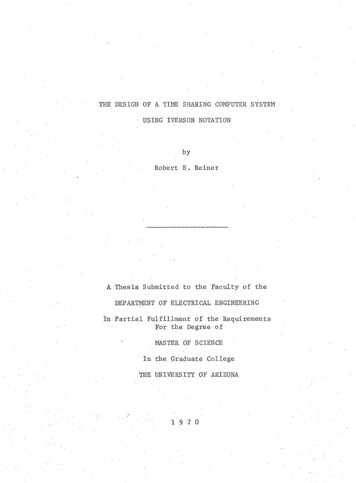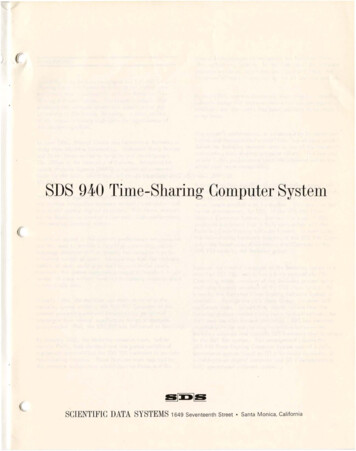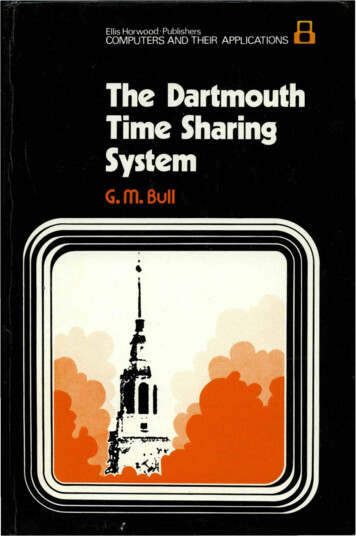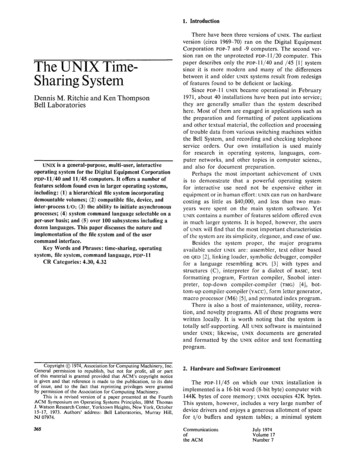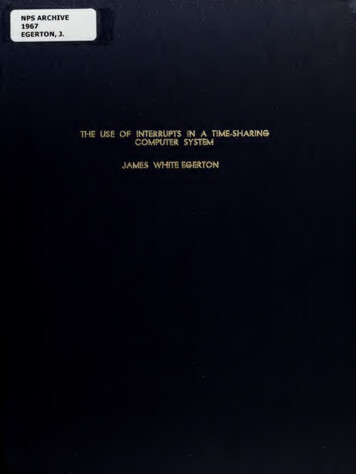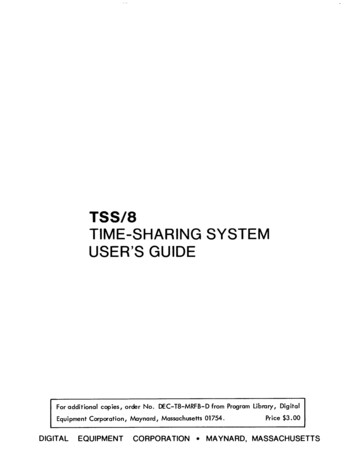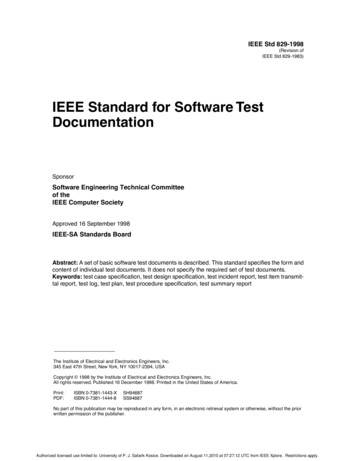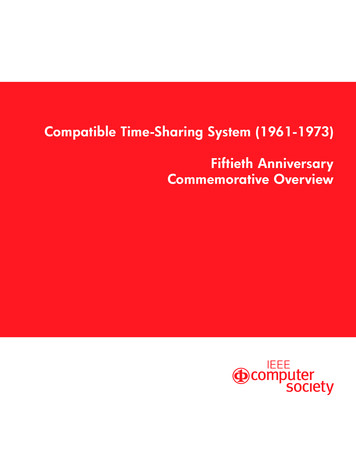
Transcription
Compatible Time-Sharing System (1961-1973)Fiftieth AnniversaryCommemorative Overview
The Compatible Time Sharing System (1961–1973)Fiftieth AnniversaryCommemorative Overview
The design of the cover, half-title page (reverse side of this page), and main titlepage mimics the design of the 1963 book The Compatible Time-Sharing System:A Programmer’s Guide from the MIT Press.
The Compatible Time Sharing System (1961–1973)Fiftieth AnniversaryCommemorative OverviewEdited byDavid Walden and Tom Van VleckWith contributions byFernando CorbatóMarjorie DaggettRobert DaleyPeter DenningDavid Alan GrierRichard MillsRoger RoachAllan Scherr
Copyright 2011 David Walden and Tom Van VleckAll rights reserved.Single copies may be printed for personal use. Write to us at ctss@multicians.orgfor a PDF suitable for two-sided printing of multiple copies for non-profit academic orscholarly use.IEEE Computer Society2001 L Street N.W., Suite 700Washington, DC 20036-4928USAFirst print edition June 2011 (web revision 03)The web edition at /historyis being updated from the print edition to correct mistakes and add new information.The change history is on page 50.
To Fernando Corbatóand his MIT collaboratorsin creating CTSS
Contents12345Preface . . . . . . . . . . . . . . . . . . .Acknowledgments . . . . . . . . . . . . .MIT nomenclature and abbreviations . . .Early history of CTSS . . . . . . . . . . .The IBM 7094 and CTSS at MIT . . . . . .Uses . . . . . . . . . . . . . . . . . . . .Memories and views of CTSS . . . . . . .Fernando Corbató . . . . . . . . . . .Marjorie Daggett . . . . . . . . . . . .Robert Daley . . . . . . . . . . . . . .Richard Mills . . . . . . . . . . . . . .Tom Van Vleck . . . . . . . . . . . . .Roger Roach . . . . . . . . . . . . . .Allan Scherr . . . . . . . . . . . . . .Peter Denning . . . . . . . . . . . . .David Alan Grier . . . . . . . . . . . .Also from the MIT/Cambridge environmentBibliography . . . . . . . . . . . . . . . .ixixx1517212122242631343537394143
PrefaceTime-sharing was in the air in 1961. John McCarthy had been thinking about it since 1955and in 1959 wrote a memo proposing a time-sharing system for the IBM 709 computer atMIT. Fernando Corbató and two of his MIT Computer Center staff members, Robert Daleyand Marjorie Merwin, starting working on the design of the Compatible Time SharingSystem (CTSS) in the spring of 1961. The system was first demonstrated in November of1961. (By 1963 CTSS was stable, large scale, operational system — proof positive of thefeasibility of time sharing.) Thus, 2011 is the Fiftieth Anniversary of the birth of CTSS, amanifestly appropriate time to review the history of CTSS.In the rest of this commemorative brochure, we sketch the history of CTSS, includeretrospective memories from several of the key CTSS personnel and others, discussthe uses of CTSS and the impact it had on the computing world, and provide a fairlycomprehensive bibliography.CTSS has been frequently mentioned in the archival literature of computing. Inparticular, volume 14, number 1 (1992), of the IEEE Annals of the History of Computingwas largely dedicated to a discussion of the CTSS system.1 In October 1988 prior Annalseditors John A. N. Lee and Robert Rosin attended a 25th Anniversary celebration of MIT’sProject MAC (the 27th anniversary of CTSS). At that time they held a group interview withseveral people who had been close to CTSS including Professor Corbató. That interviewsession and other materials on CTSS became the content of the 1992 issue of the Annals(the 31st anniversary of CTSS).That prior effort was by personnel of the IEEE Computer Society was primarily aboutcapturing the history of CTSS. Now we of the Society History Committee are able to givea proper celebratory salute to CTSS at the time of the 50th anniversary of its birth.Note: Because we are using print-on-demand technology and on-line posting todisseminate this brochure, we can do an update if we learn more about CTSS.AcknowledgmentsFernando Corbató was the primary motivating force for CTSS. He started the 1961 workon the system with Marjorie Daggett and Robert Daley. We are fortunate to have beenable to talk to the three of them as we prepared this commemorative brochure in 2011.Tom Van Vleck has been my most active supporter in the development and production of this brochure. He allowed his 7094-and-CTSS web page to be adapted and includedas Section 2 of this document. He provided pointers to numerous sources of informationabout CTSS. He suggested who I should talk to, including making an introduction toRoger Roach. He provided photographs. He reviewed every page as this document wasdrafted and provided corrections, additions, and other insight and guidance. Thank you,Tom, for serving with me as editor of this commemorative brochure. Creating it wouldhave been impossible without you.We solicited comments about CTSS from other people who were involved with thesystem or had views of it. Their names are noted with their contributions in Section 4(page 21 — they are also listed in the table of contents). Thank you, all.1MIT92a.
xPrefaceIn late 2010, David Alan Grier of the IEEE Computer Society brought to my attention that 2011 would be the fiftieth anniversary of CTSS, and he encouraged me to dosomething about this anniversary. Thank you, David.Matthias Bärwolff spotted several typos in a draft of this document. Wally Weinergave me a photo of the CTSS manual cover which I mimicked. Steve Peter talked to meabout the typefont used on the cover of the CTSS manual. Roger Roach provided mewith a copy of a DVD with scans of lots of original CTSS documentation. Paul Pierceenabled me to take a photo of the 7094 console in his computer collection. IBM CorporateArchivist Paul Lasewicz provided an image of a 7094 system. Karl Berry reviewed theaccuracy of the colophon. The hard copy version was printed by Martin and Lily Sudarmaof Copyman of Portland, OR.Hard copies of this brochure will be given to everyone who contributed to it as atoken of appreciation. I hope that Tom Van Vleck and Roger Roach will accept my offerto post on-line copies of the brochure with their various web-based CTSS repositoriesand descriptions.Most particularly, we are grateful to everyone who worked on CTSS over the years,helping to make it available and the fundamental influence on the post-1961 future ofcomputing that it was. Hence the words on the dedication page.MIT nomenclature and abbreviationsThe MIT community typically refers to MIT buildings by their numbers, not names, forinstance, Building 26, Building 39, and Building 20. Building 26 was the original locationof the Computation Center and CTSS system. The Computation Center later moved toBuilding 39. Building 26 was next to the famous Building 20 (now gone) which housedMIT’s Research Laboratory of Electronics (RLE) and other entities.Perhaps curiously, the building housing Project MAC, 545 Technology Square in acomplex of buildings known collectively as Technology Square, was typically not referredby number; rather one would say just say something like “I’m going over to Tech Square,”meaning 545 Tech Square.A couple of other abbreviations relevant to this document are ESL (Electronic Systems Laboratory), and DSR (Division of Sponsored Research).We have not attempted to try for consistency among the alternatives of “CompCenter,” “Computer Center,” and “Computation Center.”David Walden, ChairIEEE Computer Society History CommitteeJune 1, 2011dave@walden-family.com
1. Early history of CTSSTime-sharing was an idea for which the time was technologically ripe in 1961. Variouspeople were talking about time sharing; and, over the next decade or two, many timesharing systems were developed.From the existing historical record,1 we can piece together a sketch of the peopleand ideas that resulted in CTSS being created at MIT in 1961, becoming the first significantdemonstration that time-sharing was really possible.2 This chapter does not describeCTSS, only its early history. For a description of CTSS, read Section 2 before or after thischapter, or in parallel.Fernando Corbató transferred from Caltech to MIT to work on his PhD in physics. AtMIT Corby (as he is called by everyone who knows him), became a student of ProfessorPhilip Morse. Morse was a physicist, and is called the father of operations researchby some; he had insight that computers and computation were going to be a big dealbefore many others came to understand it. Morse arranged a research assistantship thatallowed Corby to become familiar with the then current computer technology — frompunched cards to programming the Whirlwind computer (the early core-memory-based,MIT-developed computer at which a generation of later computing innovators got theirfirst taste of interactive computer access). As part of Corby’s thesis work, which involved“doing energy band calculations in graphite, in carbon,”3 he also learned to “write bigprograms, to debug them, to get a complete hands on feel for working with programs,organizing them, and learning the ropes of how to use a computer.” John Little and Corbyalso used Whirlwind to create thick book containing a “numerical table of coefficients forexpanding spheroidal wave functions.”4After his PhD, Corby was hired by Morse as a research assistant in the ComputationCenter, of which Morse was head. Morse had arranged for IBM to provide an IBM 704computer to the MIT Computation Center. Morse put Corby in charge of managing otherComputation Center research assistants, giving Corby a bit of administrative experience.Corby also got to attend meetings SHARE (the IBM user’s group) to thus keep up withwhat else was going on in computing. Eventually Professor Frank Verzuh, who wasassociate director of the Computation Center (Morse was head), left and Corby took overas associate director.The Computation Center had opened in 1957 and by 1958 and 1959, it was overloaded. People in science and engineering were using computers more, which FORTRANhad helped facilitate. However, typically it took repeated batch submissions to get aprogram working. Batch processing maximized utilization of the computer rather thanoptimizing throughput of getting programs written.The people who had had hands on experience with computers such as Whirlwind,the TX-0 (an early transistor-based computer developed at MIT Lincoln Laboratory and1Corbató63a (preface), Corbató89, Corbató06, Hauben97, McCarthy89, MIT92a. 2 The vendorsof the then prevalent batch processing computer systems were mostly not thinking in terms oftime sharing in 1961. 3 Corbató06, p 5. 4 Corby has said that this was “one of the earliestexamples of trying to do automatic printing.”
2Early history of CTSSlater moved to RLE in Building 20 at MIT), and so on were particularly anxious to movecomputers and computing in the direction of interactiveness with the computer. Inparticular Professor John McCarthy, who had come from Dartmouth to be on the MITfaculty, was promoting the idea of time sharing. (According to Corby, McCarthy did thebest job of articulating the need for interactive computing.) Also Professor Herb Teagerwas interested in hardware for time-sharing, and Morse had arranged some funding forhim, and he was going to develop a time-sharing system.Corby saw Teager’s ideas as too grandiose and thought that a modest demo couldbe created on the IBM 709 in the computer center that would help people grasp whyinteractive computer use might be a good thing.Corby states that he began talking with Marge Daggett (then Marge Merwin) andBob Daley of the Computation Center staff about the system design in the spring of1961, and the original demonstration was working by November of that year. They gotIBM to provide an interrupt capability for the machine (an off-the-shelf change) whichallowed them to take control of the machine. They created a special version of theoperating system (which came to be known as CTSS). This operating system set aside 5kilowords of memory (of 32kw total) for the time-sharing supervisor (and for bufferingtypewriter terminal input and output). Herb Teager had made four Flexowriters intospecial terminals, and these would work with the IBM 709. CTSS used tape drives to storethe programs and files of the users of the four terminals. It was crude, but that was theoriginal configuration for the desired demonstration of interactive computer use, and itallowed the traditional batch processing system to still operate (that was the “compatible”part of Compatible Time-Sharing System). Corby wrote the now famous first CTSS paper,with Daggett and Daley listed as co-authors,5 in January 1962 for presentation in May1962.I asked Corby how it came to be that Marge and Bob were the other earliest involvedpeople in CTSS. Corby explained,6 “CTSS started out not as a planned project, but ratheras an effort to see if the timesharing concept, advocated eloquently by John McCarthy,could be demonstrated by some judicious programming. Marge and Bob were bothinterested and were probably the two best programmers on the staff. So what began as ademo turned into a more and more viable system as the pieces began to fall in place.”Marge remembers that initially only Corby and she were working on the project,spending “a lot of time conferring and hashing and re-hashing problems.” She alsoremembers, “having to do testing at odd hours and sitting at a listing after 5pm tryingto figure out what went wrong.” She remembers it was a big exciting day when it finallyworked for two typewriters. “There was still a lot to do, but conceptually it was prettymuch there — very exciting.”7Bob remembers Corby writing the core of the time-s
Time-sharing was in the air in 1961. John McCarthy had been thinking about it since 1955 and in 1959 wrote a memo proposing a time-sharing system for the IBM 709 computer at MIT. Fernando Corbató and two of his MIT Computer Center staff members, Robert Daley and Marjorie Merwin, starting working on the design of the Compatible Time Sharing


